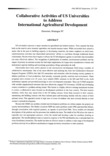Collaborative Activities of US Universities to Address International Agricultural Development
JIRCAS international symposium series
| ISSN | 13406108 |
|---|---|
| NII recode ID (NCID) | AA1100908X |

Full text
intlsymp-12_117-124.pdf295.17 KB
US universities represent a major resource in agricultural and related sciences. Their capacity has been built on the need to serve domestic agriculture and natural resource issues. While universities have played a major role in the past in building capacity in developing countries, the donor emphasis on short-term, implementation activities has diminished universities' ability to contribute through traditional donor relationships. Recent events have begun to refocus the US development agenda on activities that universities can more effectively address. The recognition of globalization of markets, environmental problems and the impact of poverty on national security has had major implications for longer-term commitment to human and institutional capacity building and knowledge generations; things universities do well.
Universities have been active players in the international development field using a number of collaborative mechanisms. One of the most effective and enduring has been the Collaborative Research Support Programs (CRSPs) that link US researchers and extension with developing country partners to address problems of food production, food security, economic growth, nutrition and environment. These programs have existed over 25 years, have trained 5000+ students to the MS and PhD levels, built institutional capacity and provided knowledge to solve development constraints. There are 9 CRSP programs with variable organizational structures that have effectively engaged US University, CGIAR and developing country scientists in a problem-solving format. This format is a highly effective training mechanism because it creates a collaborative team focused on development problems in the host country. The host country students, while they may spend time in the US taking courses, focus their research in their country, maintaining and building contacts with their national peers and becoming familiar with the context of their national issues. This approach results in high rates of return of students who have invested directly in their country's national development.
Because the CRSPs are problem oriented and development problems are seldom simple, the projects are usually interdisciplinary. The Global Livestock CRSP has used a problem model (PM) approach that defines, through consultation with regional partners, an agenda of prioritized PMs. These models are detailed descriptions of the problem and the processes that underlie the issue. The detail of the PM allows the team to logically sort out appropriate partners, refine the model and develop a plan for ancillary funding as appropriate. The interdisciplinary team is created in response to the PM and therefore has a rationale basis for cross disciplinary interaction. The model has been an effective means to address a wide range of development problems and may be an effective mechanism to engage university researchers in other countries.
Universities have been active players in the international development field using a number of collaborative mechanisms. One of the most effective and enduring has been the Collaborative Research Support Programs (CRSPs) that link US researchers and extension with developing country partners to address problems of food production, food security, economic growth, nutrition and environment. These programs have existed over 25 years, have trained 5000+ students to the MS and PhD levels, built institutional capacity and provided knowledge to solve development constraints. There are 9 CRSP programs with variable organizational structures that have effectively engaged US University, CGIAR and developing country scientists in a problem-solving format. This format is a highly effective training mechanism because it creates a collaborative team focused on development problems in the host country. The host country students, while they may spend time in the US taking courses, focus their research in their country, maintaining and building contacts with their national peers and becoming familiar with the context of their national issues. This approach results in high rates of return of students who have invested directly in their country's national development.
Because the CRSPs are problem oriented and development problems are seldom simple, the projects are usually interdisciplinary. The Global Livestock CRSP has used a problem model (PM) approach that defines, through consultation with regional partners, an agenda of prioritized PMs. These models are detailed descriptions of the problem and the processes that underlie the issue. The detail of the PM allows the team to logically sort out appropriate partners, refine the model and develop a plan for ancillary funding as appropriate. The interdisciplinary team is created in response to the PM and therefore has a rationale basis for cross disciplinary interaction. The model has been an effective means to address a wide range of development problems and may be an effective mechanism to engage university researchers in other countries.
| Creator | Montague W. Demment |
|---|---|
| Publisher | Japan International Research Center for Agricultural Sciences |
| Available Online | |
| Issue | 12 |
| spage | 117 |
| epage | 124 |
| Language | eng |
